Financial Analysis and Decision Making Report: Harvey Homes
VerifiedAdded on 2020/07/22
|27
|5456
|414
Report
AI Summary
This report presents a comprehensive financial analysis of Harvey Homes, examining its financial statements, including the statement of profit and loss, statement of financial position, and statement of cash flow. The analysis includes key financial ratios such as gross margin, net margin, return on capital employed, current ratio, quick ratio, and long-term debt to total assets. The report also covers market segment analysis, management forecasts, investment appraisal techniques, and sources of finance. Furthermore, it discusses non-financial factors, specifically highlighting the importance of hiring locals and making corporate connections. The executive summary highlights key findings, such as the current ratio's implications and the need to improve performance in certain regions. The report concludes with recommendations for improving financial performance and decision-making.
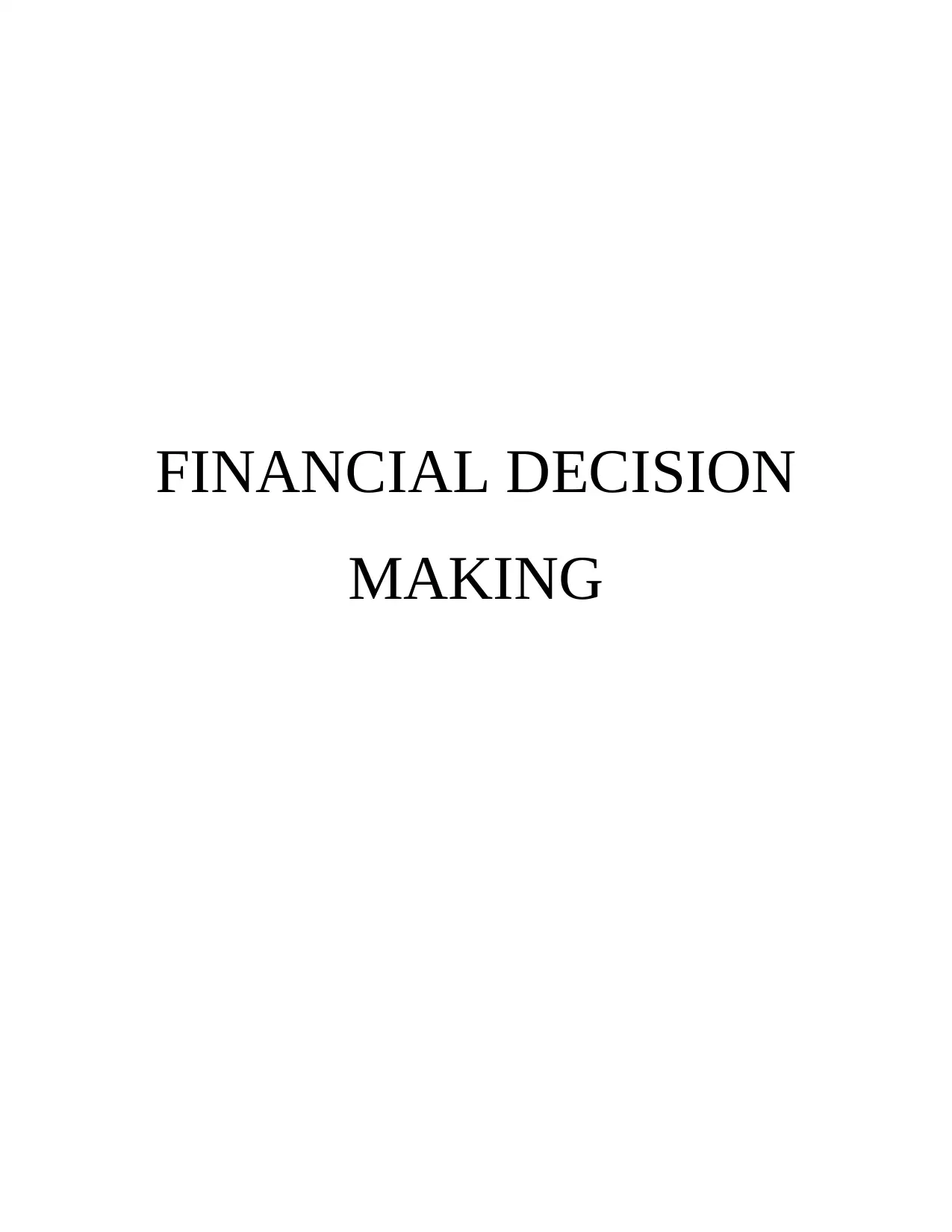
FINANCIAL DECISION
MAKING
MAKING
Paraphrase This Document
Need a fresh take? Get an instant paraphrase of this document with our AI Paraphraser
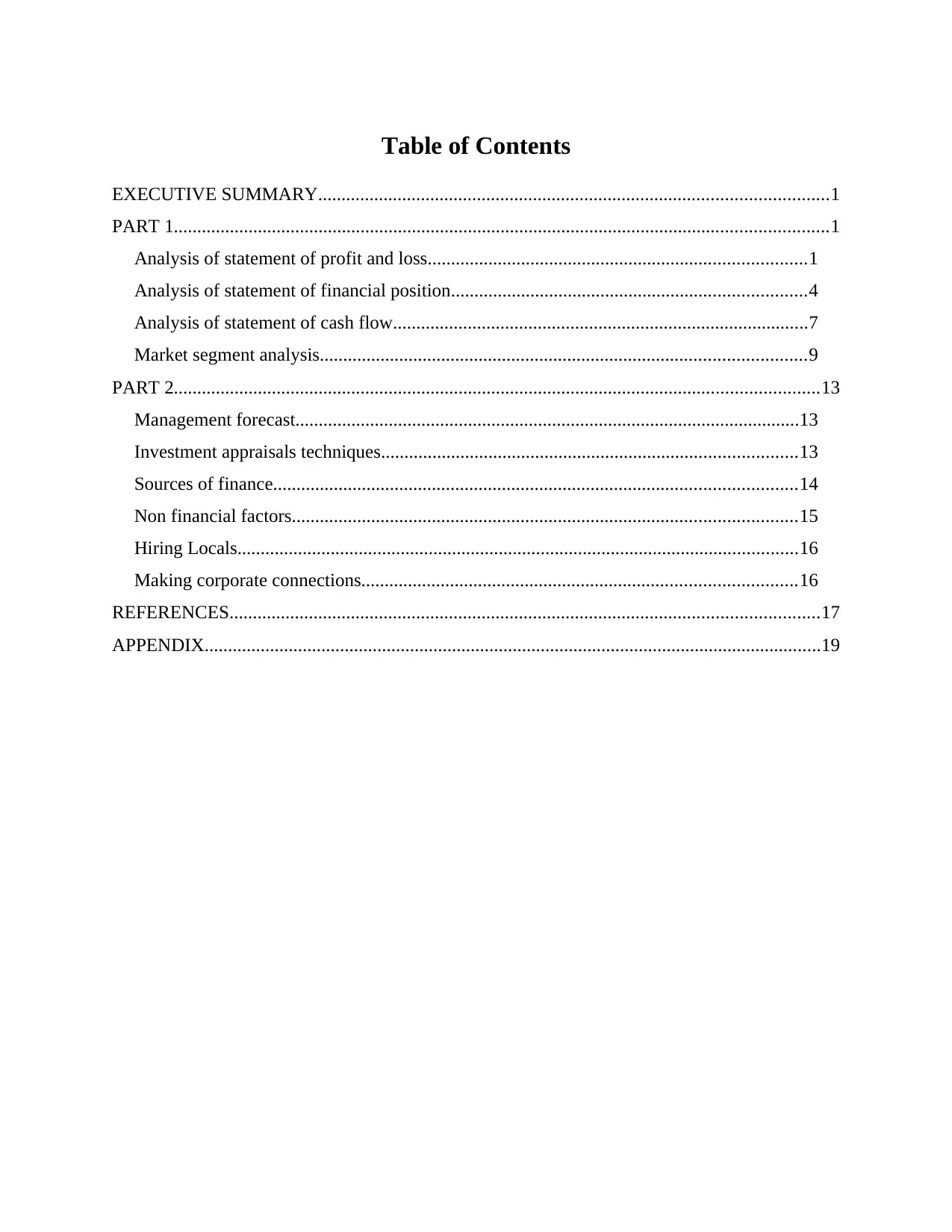
Table of Contents
EXECUTIVE SUMMARY.............................................................................................................1
PART 1............................................................................................................................................1
Analysis of statement of profit and loss.................................................................................1
Analysis of statement of financial position............................................................................4
Analysis of statement of cash flow.........................................................................................7
Market segment analysis........................................................................................................9
PART 2..........................................................................................................................................13
Management forecast............................................................................................................13
Investment appraisals techniques.........................................................................................13
Sources of finance................................................................................................................14
Non financial factors............................................................................................................15
Hiring Locals........................................................................................................................16
Making corporate connections.............................................................................................16
REFERENCES..............................................................................................................................17
APPENDIX....................................................................................................................................19
EXECUTIVE SUMMARY.............................................................................................................1
PART 1............................................................................................................................................1
Analysis of statement of profit and loss.................................................................................1
Analysis of statement of financial position............................................................................4
Analysis of statement of cash flow.........................................................................................7
Market segment analysis........................................................................................................9
PART 2..........................................................................................................................................13
Management forecast............................................................................................................13
Investment appraisals techniques.........................................................................................13
Sources of finance................................................................................................................14
Non financial factors............................................................................................................15
Hiring Locals........................................................................................................................16
Making corporate connections.............................................................................................16
REFERENCES..............................................................................................................................17
APPENDIX....................................................................................................................................19
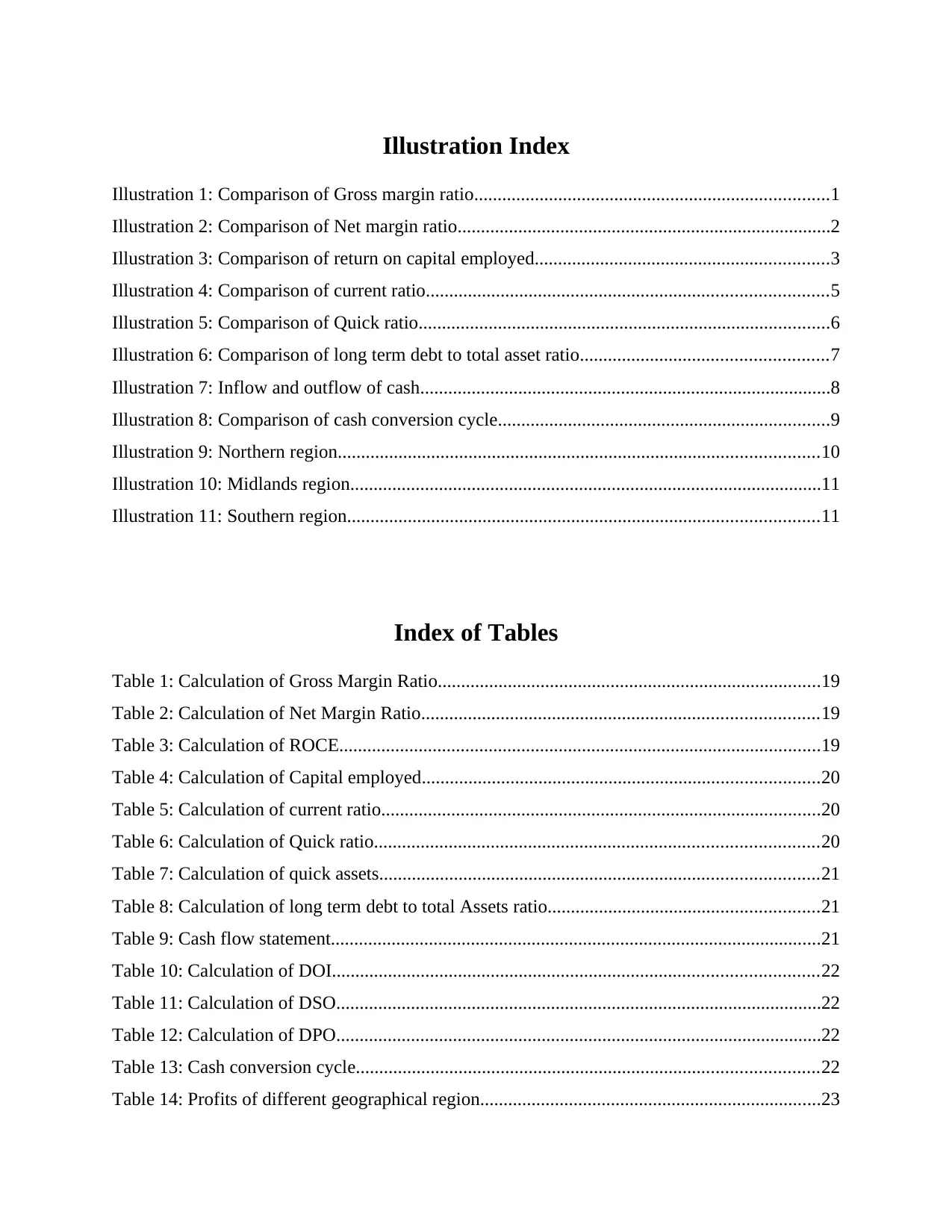
Illustration Index
Illustration 1: Comparison of Gross margin ratio............................................................................1
Illustration 2: Comparison of Net margin ratio................................................................................2
Illustration 3: Comparison of return on capital employed...............................................................3
Illustration 4: Comparison of current ratio......................................................................................5
Illustration 5: Comparison of Quick ratio........................................................................................6
Illustration 6: Comparison of long term debt to total asset ratio.....................................................7
Illustration 7: Inflow and outflow of cash........................................................................................8
Illustration 8: Comparison of cash conversion cycle.......................................................................9
Illustration 9: Northern region.......................................................................................................10
Illustration 10: Midlands region.....................................................................................................11
Illustration 11: Southern region.....................................................................................................11
Index of Tables
Table 1: Calculation of Gross Margin Ratio..................................................................................19
Table 2: Calculation of Net Margin Ratio.....................................................................................19
Table 3: Calculation of ROCE.......................................................................................................19
Table 4: Calculation of Capital employed.....................................................................................20
Table 5: Calculation of current ratio..............................................................................................20
Table 6: Calculation of Quick ratio...............................................................................................20
Table 7: Calculation of quick assets..............................................................................................21
Table 8: Calculation of long term debt to total Assets ratio..........................................................21
Table 9: Cash flow statement.........................................................................................................21
Table 10: Calculation of DOI........................................................................................................22
Table 11: Calculation of DSO........................................................................................................22
Table 12: Calculation of DPO........................................................................................................22
Table 13: Cash conversion cycle...................................................................................................22
Table 14: Profits of different geographical region.........................................................................23
Illustration 1: Comparison of Gross margin ratio............................................................................1
Illustration 2: Comparison of Net margin ratio................................................................................2
Illustration 3: Comparison of return on capital employed...............................................................3
Illustration 4: Comparison of current ratio......................................................................................5
Illustration 5: Comparison of Quick ratio........................................................................................6
Illustration 6: Comparison of long term debt to total asset ratio.....................................................7
Illustration 7: Inflow and outflow of cash........................................................................................8
Illustration 8: Comparison of cash conversion cycle.......................................................................9
Illustration 9: Northern region.......................................................................................................10
Illustration 10: Midlands region.....................................................................................................11
Illustration 11: Southern region.....................................................................................................11
Index of Tables
Table 1: Calculation of Gross Margin Ratio..................................................................................19
Table 2: Calculation of Net Margin Ratio.....................................................................................19
Table 3: Calculation of ROCE.......................................................................................................19
Table 4: Calculation of Capital employed.....................................................................................20
Table 5: Calculation of current ratio..............................................................................................20
Table 6: Calculation of Quick ratio...............................................................................................20
Table 7: Calculation of quick assets..............................................................................................21
Table 8: Calculation of long term debt to total Assets ratio..........................................................21
Table 9: Cash flow statement.........................................................................................................21
Table 10: Calculation of DOI........................................................................................................22
Table 11: Calculation of DSO........................................................................................................22
Table 12: Calculation of DPO........................................................................................................22
Table 13: Cash conversion cycle...................................................................................................22
Table 14: Profits of different geographical region.........................................................................23
⊘ This is a preview!⊘
Do you want full access?
Subscribe today to unlock all pages.

Trusted by 1+ million students worldwide

EXECUTIVE SUMMARY
Analysing the financial statements helps in making comparative analysis of sales, profits,
investments etc. which further contributes to better decision making. Harvey homes is involved
in creating quality homes to people. The key findings of the report are that the current ratio of the
business is on higher side leading to productivity of the current assets. Further, the Harvey is not
earning mush revenues from Midland region hence, require improving product mix. The
company is low at its operating cash and therefore require working upon its operating income in
order to conduct its day to day business. The entity have been able to get loan for 150 million
through which it will be managing its cash requirements. There is an increase in revenue of the
entity also there is overall increase in the profits of the entity I comparison to the figures of
previous year.
PART 1
Analysis of statement of profit and loss
Gross Margin Ratio
Gross margin ratio reveals the profit the company has earned after paying all the cost of
goods sold. It indicates the financial health of the company by indicating the gross profit it has
1
Gross profit Net sales
0
200
400
600
800
1000
1200
1400
2016
2015
Illustration 1: Comparison of Gross margin ratio
Analysing the financial statements helps in making comparative analysis of sales, profits,
investments etc. which further contributes to better decision making. Harvey homes is involved
in creating quality homes to people. The key findings of the report are that the current ratio of the
business is on higher side leading to productivity of the current assets. Further, the Harvey is not
earning mush revenues from Midland region hence, require improving product mix. The
company is low at its operating cash and therefore require working upon its operating income in
order to conduct its day to day business. The entity have been able to get loan for 150 million
through which it will be managing its cash requirements. There is an increase in revenue of the
entity also there is overall increase in the profits of the entity I comparison to the figures of
previous year.
PART 1
Analysis of statement of profit and loss
Gross Margin Ratio
Gross margin ratio reveals the profit the company has earned after paying all the cost of
goods sold. It indicates the financial health of the company by indicating the gross profit it has
1
Gross profit Net sales
0
200
400
600
800
1000
1200
1400
2016
2015
Illustration 1: Comparison of Gross margin ratio
Paraphrase This Document
Need a fresh take? Get an instant paraphrase of this document with our AI Paraphraser
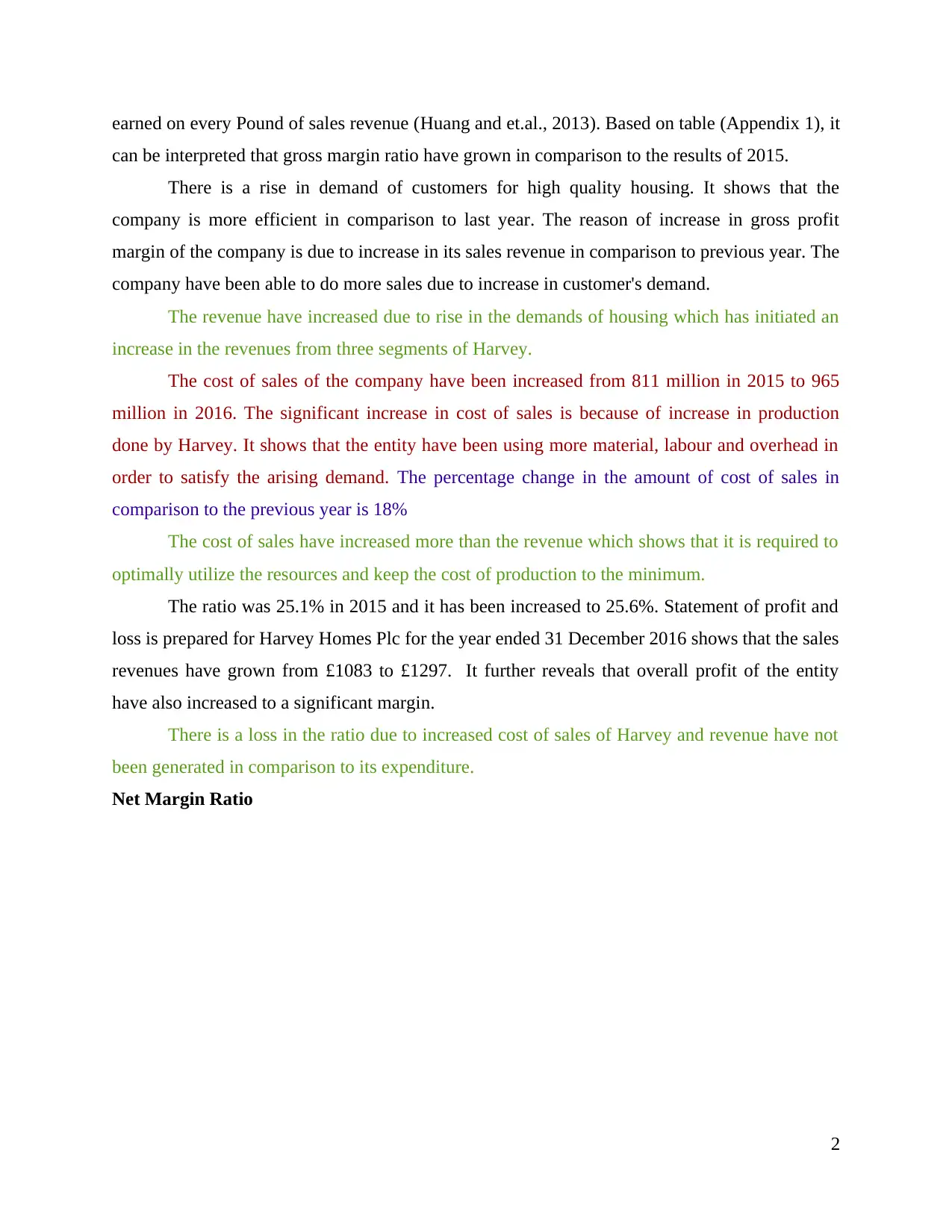
earned on every Pound of sales revenue (Huang and et.al., 2013). Based on table (Appendix 1), it
can be interpreted that gross margin ratio have grown in comparison to the results of 2015.
There is a rise in demand of customers for high quality housing. It shows that the
company is more efficient in comparison to last year. The reason of increase in gross profit
margin of the company is due to increase in its sales revenue in comparison to previous year. The
company have been able to do more sales due to increase in customer's demand.
The revenue have increased due to rise in the demands of housing which has initiated an
increase in the revenues from three segments of Harvey.
The cost of sales of the company have been increased from 811 million in 2015 to 965
million in 2016. The significant increase in cost of sales is because of increase in production
done by Harvey. It shows that the entity have been using more material, labour and overhead in
order to satisfy the arising demand. The percentage change in the amount of cost of sales in
comparison to the previous year is 18%
The cost of sales have increased more than the revenue which shows that it is required to
optimally utilize the resources and keep the cost of production to the minimum.
The ratio was 25.1% in 2015 and it has been increased to 25.6%. Statement of profit and
loss is prepared for Harvey Homes Plc for the year ended 31 December 2016 shows that the sales
revenues have grown from £1083 to £1297. It further reveals that overall profit of the entity
have also increased to a significant margin.
There is a loss in the ratio due to increased cost of sales of Harvey and revenue have not
been generated in comparison to its expenditure.
Net Margin Ratio
2
can be interpreted that gross margin ratio have grown in comparison to the results of 2015.
There is a rise in demand of customers for high quality housing. It shows that the
company is more efficient in comparison to last year. The reason of increase in gross profit
margin of the company is due to increase in its sales revenue in comparison to previous year. The
company have been able to do more sales due to increase in customer's demand.
The revenue have increased due to rise in the demands of housing which has initiated an
increase in the revenues from three segments of Harvey.
The cost of sales of the company have been increased from 811 million in 2015 to 965
million in 2016. The significant increase in cost of sales is because of increase in production
done by Harvey. It shows that the entity have been using more material, labour and overhead in
order to satisfy the arising demand. The percentage change in the amount of cost of sales in
comparison to the previous year is 18%
The cost of sales have increased more than the revenue which shows that it is required to
optimally utilize the resources and keep the cost of production to the minimum.
The ratio was 25.1% in 2015 and it has been increased to 25.6%. Statement of profit and
loss is prepared for Harvey Homes Plc for the year ended 31 December 2016 shows that the sales
revenues have grown from £1083 to £1297. It further reveals that overall profit of the entity
have also increased to a significant margin.
There is a loss in the ratio due to increased cost of sales of Harvey and revenue have not
been generated in comparison to its expenditure.
Net Margin Ratio
2
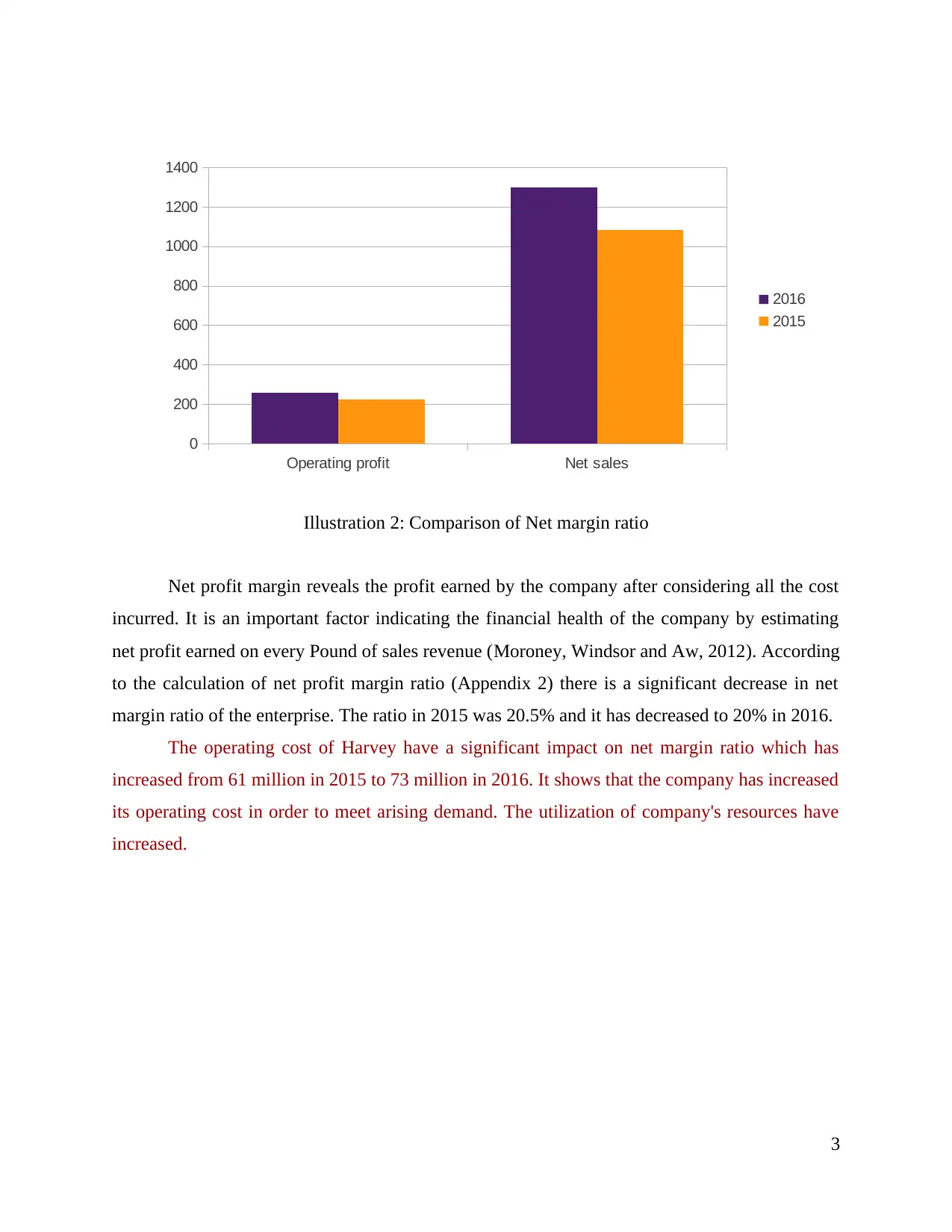
Net profit margin reveals the profit earned by the company after considering all the cost
incurred. It is an important factor indicating the financial health of the company by estimating
net profit earned on every Pound of sales revenue (Moroney, Windsor and Aw, 2012). According
to the calculation of net profit margin ratio (Appendix 2) there is a significant decrease in net
margin ratio of the enterprise. The ratio in 2015 was 20.5% and it has decreased to 20% in 2016.
The operating cost of Harvey have a significant impact on net margin ratio which has
increased from 61 million in 2015 to 73 million in 2016. It shows that the company has increased
its operating cost in order to meet arising demand. The utilization of company's resources have
increased.
3
Operating profit Net sales
0
200
400
600
800
1000
1200
1400
2016
2015
Illustration 2: Comparison of Net margin ratio
incurred. It is an important factor indicating the financial health of the company by estimating
net profit earned on every Pound of sales revenue (Moroney, Windsor and Aw, 2012). According
to the calculation of net profit margin ratio (Appendix 2) there is a significant decrease in net
margin ratio of the enterprise. The ratio in 2015 was 20.5% and it has decreased to 20% in 2016.
The operating cost of Harvey have a significant impact on net margin ratio which has
increased from 61 million in 2015 to 73 million in 2016. It shows that the company has increased
its operating cost in order to meet arising demand. The utilization of company's resources have
increased.
3
Operating profit Net sales
0
200
400
600
800
1000
1200
1400
2016
2015
Illustration 2: Comparison of Net margin ratio
⊘ This is a preview!⊘
Do you want full access?
Subscribe today to unlock all pages.

Trusted by 1+ million students worldwide
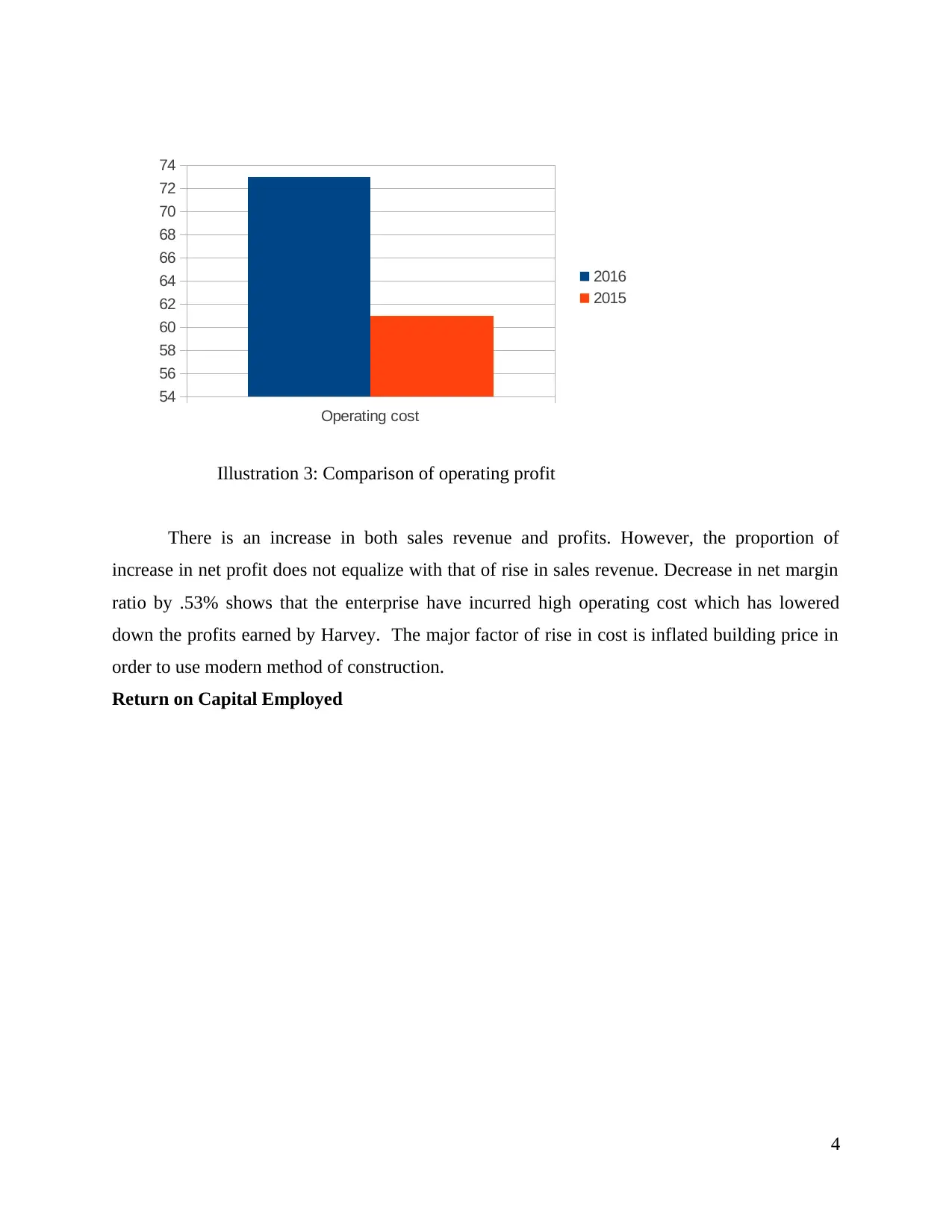
There is an increase in both sales revenue and profits. However, the proportion of
increase in net profit does not equalize with that of rise in sales revenue. Decrease in net margin
ratio by .53% shows that the enterprise have incurred high operating cost which has lowered
down the profits earned by Harvey. The major factor of rise in cost is inflated building price in
order to use modern method of construction.
Return on Capital Employed
4
Operating cost
54
56
58
60
62
64
66
68
70
72
74
2016
2015
Illustration 3: Comparison of operating profit
increase in net profit does not equalize with that of rise in sales revenue. Decrease in net margin
ratio by .53% shows that the enterprise have incurred high operating cost which has lowered
down the profits earned by Harvey. The major factor of rise in cost is inflated building price in
order to use modern method of construction.
Return on Capital Employed
4
Operating cost
54
56
58
60
62
64
66
68
70
72
74
2016
2015
Illustration 3: Comparison of operating profit
Paraphrase This Document
Need a fresh take? Get an instant paraphrase of this document with our AI Paraphraser
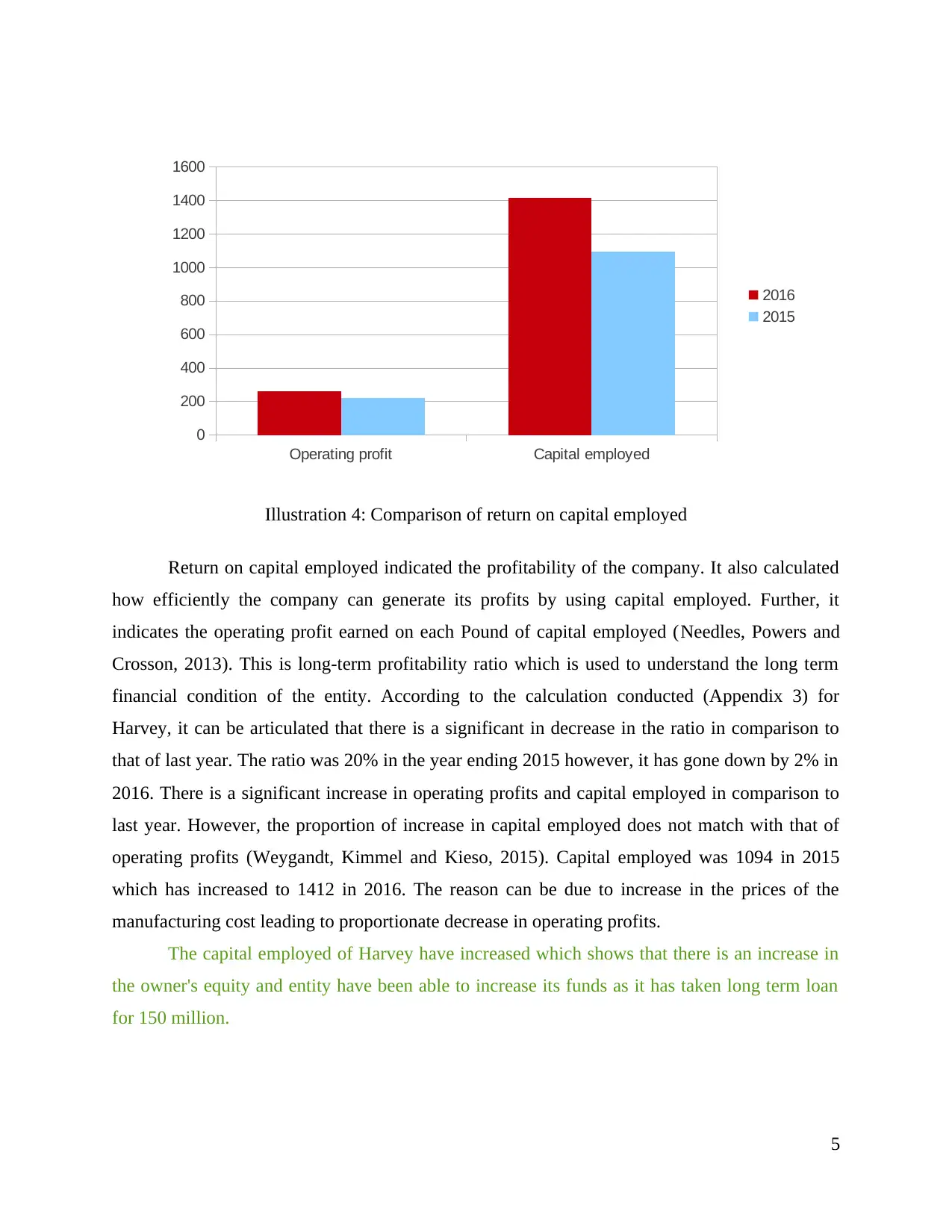
Return on capital employed indicated the profitability of the company. It also calculated
how efficiently the company can generate its profits by using capital employed. Further, it
indicates the operating profit earned on each Pound of capital employed (Needles, Powers and
Crosson, 2013). This is long-term profitability ratio which is used to understand the long term
financial condition of the entity. According to the calculation conducted (Appendix 3) for
Harvey, it can be articulated that there is a significant in decrease in the ratio in comparison to
that of last year. The ratio was 20% in the year ending 2015 however, it has gone down by 2% in
2016. There is a significant increase in operating profits and capital employed in comparison to
last year. However, the proportion of increase in capital employed does not match with that of
operating profits (Weygandt, Kimmel and Kieso, 2015). Capital employed was 1094 in 2015
which has increased to 1412 in 2016. The reason can be due to increase in the prices of the
manufacturing cost leading to proportionate decrease in operating profits.
The capital employed of Harvey have increased which shows that there is an increase in
the owner's equity and entity have been able to increase its funds as it has taken long term loan
for 150 million.
5
Operating profit Capital employed
0
200
400
600
800
1000
1200
1400
1600
2016
2015
Illustration 4: Comparison of return on capital employed
how efficiently the company can generate its profits by using capital employed. Further, it
indicates the operating profit earned on each Pound of capital employed (Needles, Powers and
Crosson, 2013). This is long-term profitability ratio which is used to understand the long term
financial condition of the entity. According to the calculation conducted (Appendix 3) for
Harvey, it can be articulated that there is a significant in decrease in the ratio in comparison to
that of last year. The ratio was 20% in the year ending 2015 however, it has gone down by 2% in
2016. There is a significant increase in operating profits and capital employed in comparison to
last year. However, the proportion of increase in capital employed does not match with that of
operating profits (Weygandt, Kimmel and Kieso, 2015). Capital employed was 1094 in 2015
which has increased to 1412 in 2016. The reason can be due to increase in the prices of the
manufacturing cost leading to proportionate decrease in operating profits.
The capital employed of Harvey have increased which shows that there is an increase in
the owner's equity and entity have been able to increase its funds as it has taken long term loan
for 150 million.
5
Operating profit Capital employed
0
200
400
600
800
1000
1200
1400
1600
2016
2015
Illustration 4: Comparison of return on capital employed
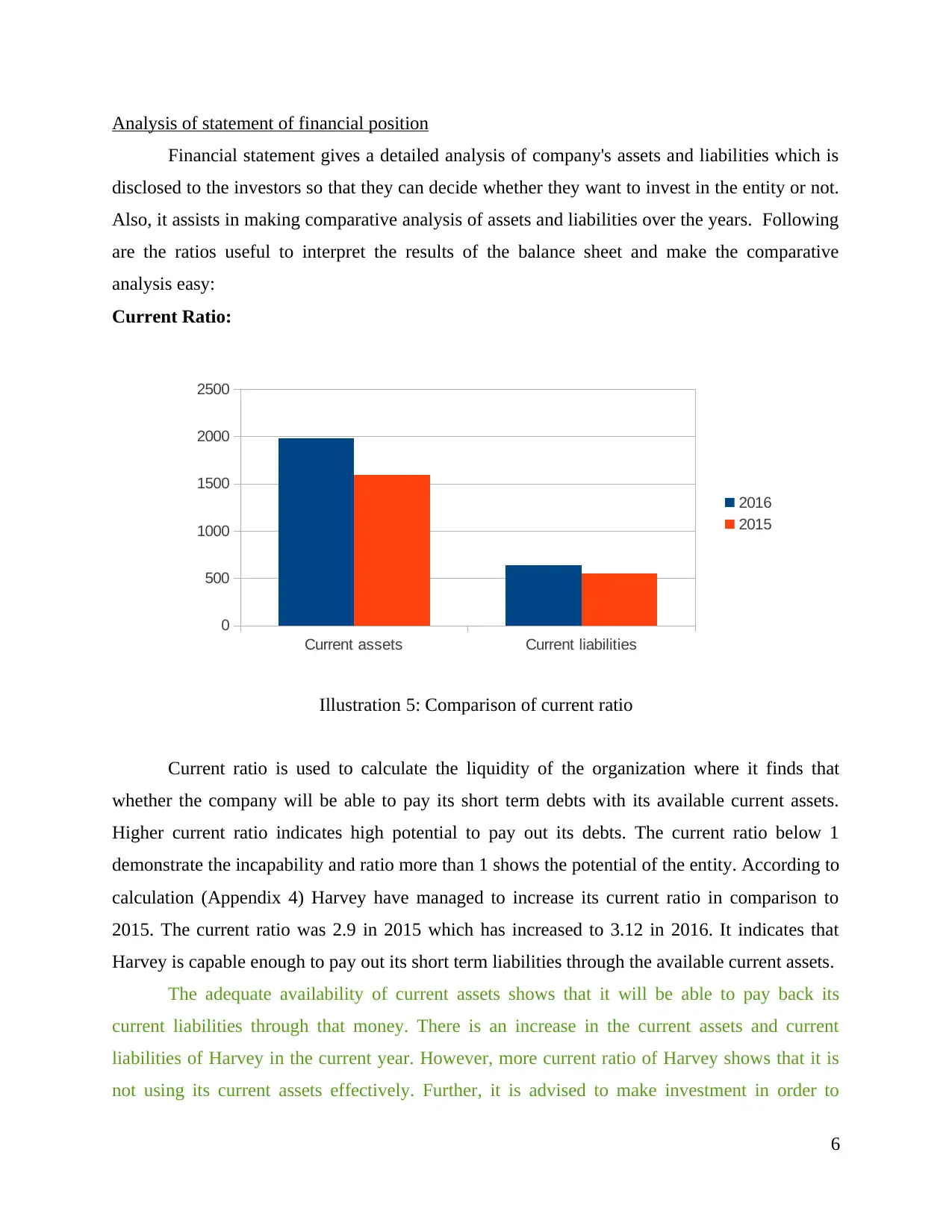
Analysis of statement of financial position
Financial statement gives a detailed analysis of company's assets and liabilities which is
disclosed to the investors so that they can decide whether they want to invest in the entity or not.
Also, it assists in making comparative analysis of assets and liabilities over the years. Following
are the ratios useful to interpret the results of the balance sheet and make the comparative
analysis easy:
Current Ratio:
Current ratio is used to calculate the liquidity of the organization where it finds that
whether the company will be able to pay its short term debts with its available current assets.
Higher current ratio indicates high potential to pay out its debts. The current ratio below 1
demonstrate the incapability and ratio more than 1 shows the potential of the entity. According to
calculation (Appendix 4) Harvey have managed to increase its current ratio in comparison to
2015. The current ratio was 2.9 in 2015 which has increased to 3.12 in 2016. It indicates that
Harvey is capable enough to pay out its short term liabilities through the available current assets.
The adequate availability of current assets shows that it will be able to pay back its
current liabilities through that money. There is an increase in the current assets and current
liabilities of Harvey in the current year. However, more current ratio of Harvey shows that it is
not using its current assets effectively. Further, it is advised to make investment in order to
6
Current assets Current liabilities
0
500
1000
1500
2000
2500
2016
2015
Illustration 5: Comparison of current ratio
Financial statement gives a detailed analysis of company's assets and liabilities which is
disclosed to the investors so that they can decide whether they want to invest in the entity or not.
Also, it assists in making comparative analysis of assets and liabilities over the years. Following
are the ratios useful to interpret the results of the balance sheet and make the comparative
analysis easy:
Current Ratio:
Current ratio is used to calculate the liquidity of the organization where it finds that
whether the company will be able to pay its short term debts with its available current assets.
Higher current ratio indicates high potential to pay out its debts. The current ratio below 1
demonstrate the incapability and ratio more than 1 shows the potential of the entity. According to
calculation (Appendix 4) Harvey have managed to increase its current ratio in comparison to
2015. The current ratio was 2.9 in 2015 which has increased to 3.12 in 2016. It indicates that
Harvey is capable enough to pay out its short term liabilities through the available current assets.
The adequate availability of current assets shows that it will be able to pay back its
current liabilities through that money. There is an increase in the current assets and current
liabilities of Harvey in the current year. However, more current ratio of Harvey shows that it is
not using its current assets effectively. Further, it is advised to make investment in order to
6
Current assets Current liabilities
0
500
1000
1500
2000
2500
2016
2015
Illustration 5: Comparison of current ratio
⊘ This is a preview!⊘
Do you want full access?
Subscribe today to unlock all pages.

Trusted by 1+ million students worldwide
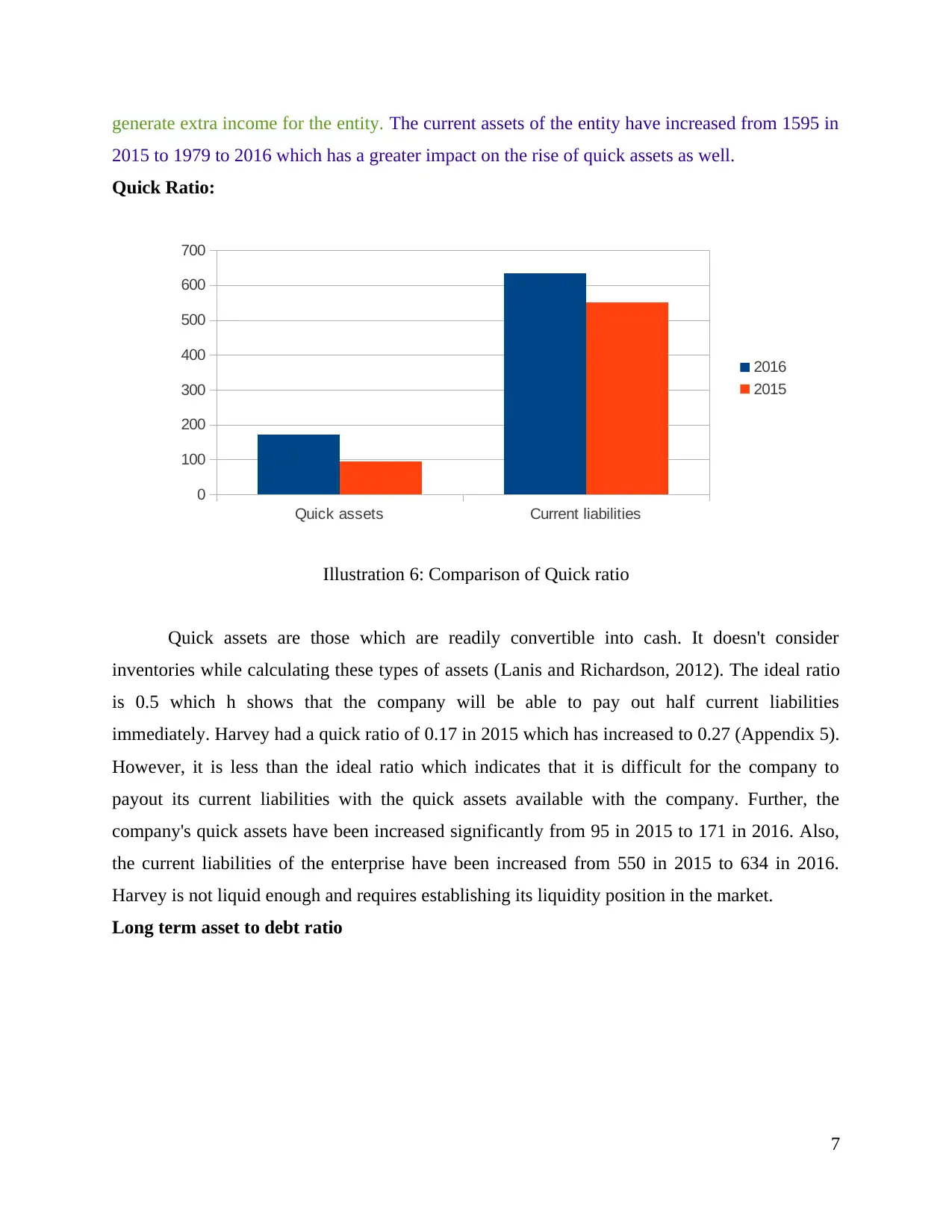
generate extra income for the entity. The current assets of the entity have increased from 1595 in
2015 to 1979 to 2016 which has a greater impact on the rise of quick assets as well.
Quick Ratio:
Quick assets are those which are readily convertible into cash. It doesn't consider
inventories while calculating these types of assets (Lanis and Richardson, 2012). The ideal ratio
is 0.5 which h shows that the company will be able to pay out half current liabilities
immediately. Harvey had a quick ratio of 0.17 in 2015 which has increased to 0.27 (Appendix 5).
However, it is less than the ideal ratio which indicates that it is difficult for the company to
payout its current liabilities with the quick assets available with the company. Further, the
company's quick assets have been increased significantly from 95 in 2015 to 171 in 2016. Also,
the current liabilities of the enterprise have been increased from 550 in 2015 to 634 in 2016.
Harvey is not liquid enough and requires establishing its liquidity position in the market.
Long term asset to debt ratio
7
Quick assets Current liabilities
0
100
200
300
400
500
600
700
2016
2015
Illustration 6: Comparison of Quick ratio
2015 to 1979 to 2016 which has a greater impact on the rise of quick assets as well.
Quick Ratio:
Quick assets are those which are readily convertible into cash. It doesn't consider
inventories while calculating these types of assets (Lanis and Richardson, 2012). The ideal ratio
is 0.5 which h shows that the company will be able to pay out half current liabilities
immediately. Harvey had a quick ratio of 0.17 in 2015 which has increased to 0.27 (Appendix 5).
However, it is less than the ideal ratio which indicates that it is difficult for the company to
payout its current liabilities with the quick assets available with the company. Further, the
company's quick assets have been increased significantly from 95 in 2015 to 171 in 2016. Also,
the current liabilities of the enterprise have been increased from 550 in 2015 to 634 in 2016.
Harvey is not liquid enough and requires establishing its liquidity position in the market.
Long term asset to debt ratio
7
Quick assets Current liabilities
0
100
200
300
400
500
600
700
2016
2015
Illustration 6: Comparison of Quick ratio
Paraphrase This Document
Need a fresh take? Get an instant paraphrase of this document with our AI Paraphraser
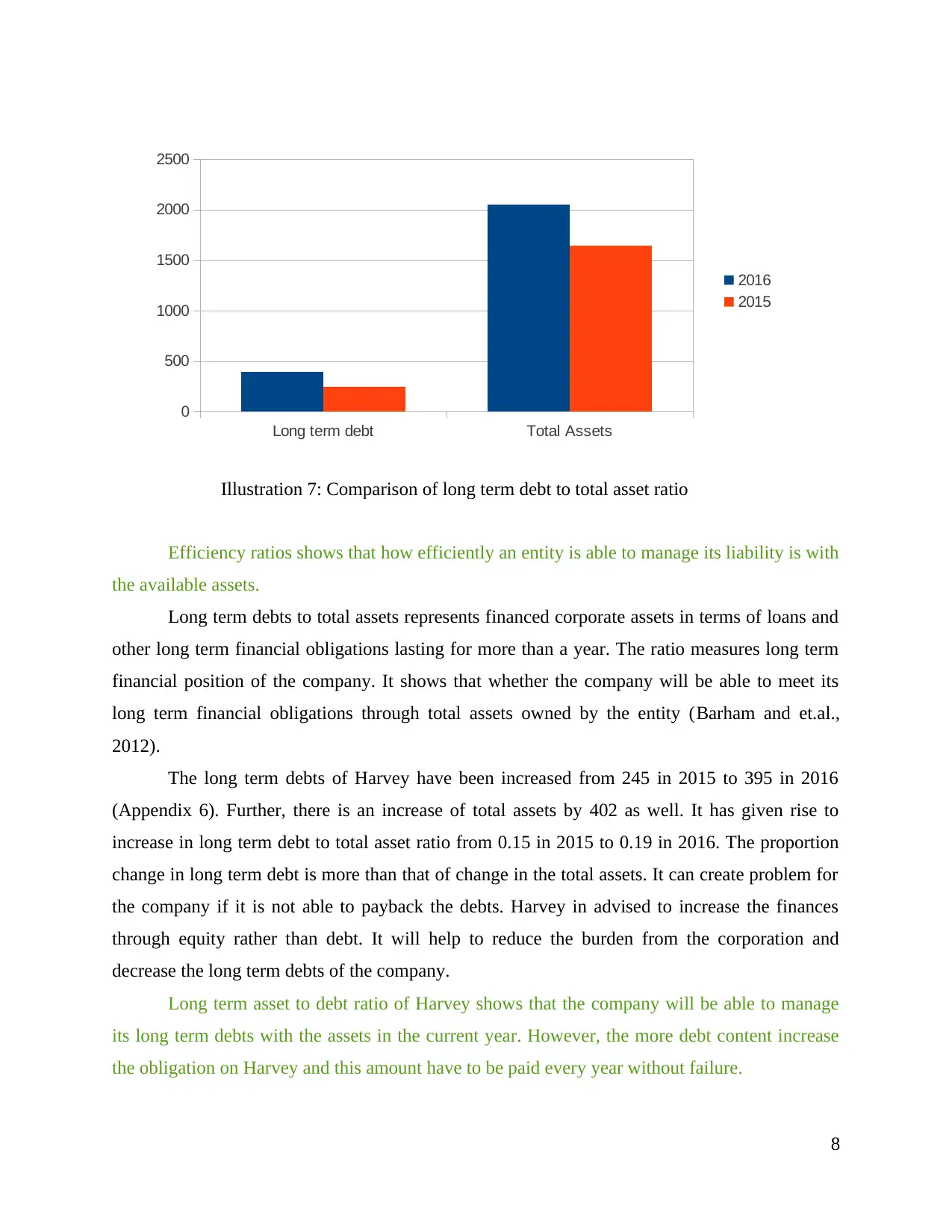
Efficiency ratios shows that how efficiently an entity is able to manage its liability is with
the available assets.
Long term debts to total assets represents financed corporate assets in terms of loans and
other long term financial obligations lasting for more than a year. The ratio measures long term
financial position of the company. It shows that whether the company will be able to meet its
long term financial obligations through total assets owned by the entity (Barham and et.al.,
2012).
The long term debts of Harvey have been increased from 245 in 2015 to 395 in 2016
(Appendix 6). Further, there is an increase of total assets by 402 as well. It has given rise to
increase in long term debt to total asset ratio from 0.15 in 2015 to 0.19 in 2016. The proportion
change in long term debt is more than that of change in the total assets. It can create problem for
the company if it is not able to payback the debts. Harvey in advised to increase the finances
through equity rather than debt. It will help to reduce the burden from the corporation and
decrease the long term debts of the company.
Long term asset to debt ratio of Harvey shows that the company will be able to manage
its long term debts with the assets in the current year. However, the more debt content increase
the obligation on Harvey and this amount have to be paid every year without failure.
8
Long term debt Total Assets
0
500
1000
1500
2000
2500
2016
2015
Illustration 7: Comparison of long term debt to total asset ratio
the available assets.
Long term debts to total assets represents financed corporate assets in terms of loans and
other long term financial obligations lasting for more than a year. The ratio measures long term
financial position of the company. It shows that whether the company will be able to meet its
long term financial obligations through total assets owned by the entity (Barham and et.al.,
2012).
The long term debts of Harvey have been increased from 245 in 2015 to 395 in 2016
(Appendix 6). Further, there is an increase of total assets by 402 as well. It has given rise to
increase in long term debt to total asset ratio from 0.15 in 2015 to 0.19 in 2016. The proportion
change in long term debt is more than that of change in the total assets. It can create problem for
the company if it is not able to payback the debts. Harvey in advised to increase the finances
through equity rather than debt. It will help to reduce the burden from the corporation and
decrease the long term debts of the company.
Long term asset to debt ratio of Harvey shows that the company will be able to manage
its long term debts with the assets in the current year. However, the more debt content increase
the obligation on Harvey and this amount have to be paid every year without failure.
8
Long term debt Total Assets
0
500
1000
1500
2000
2500
2016
2015
Illustration 7: Comparison of long term debt to total asset ratio
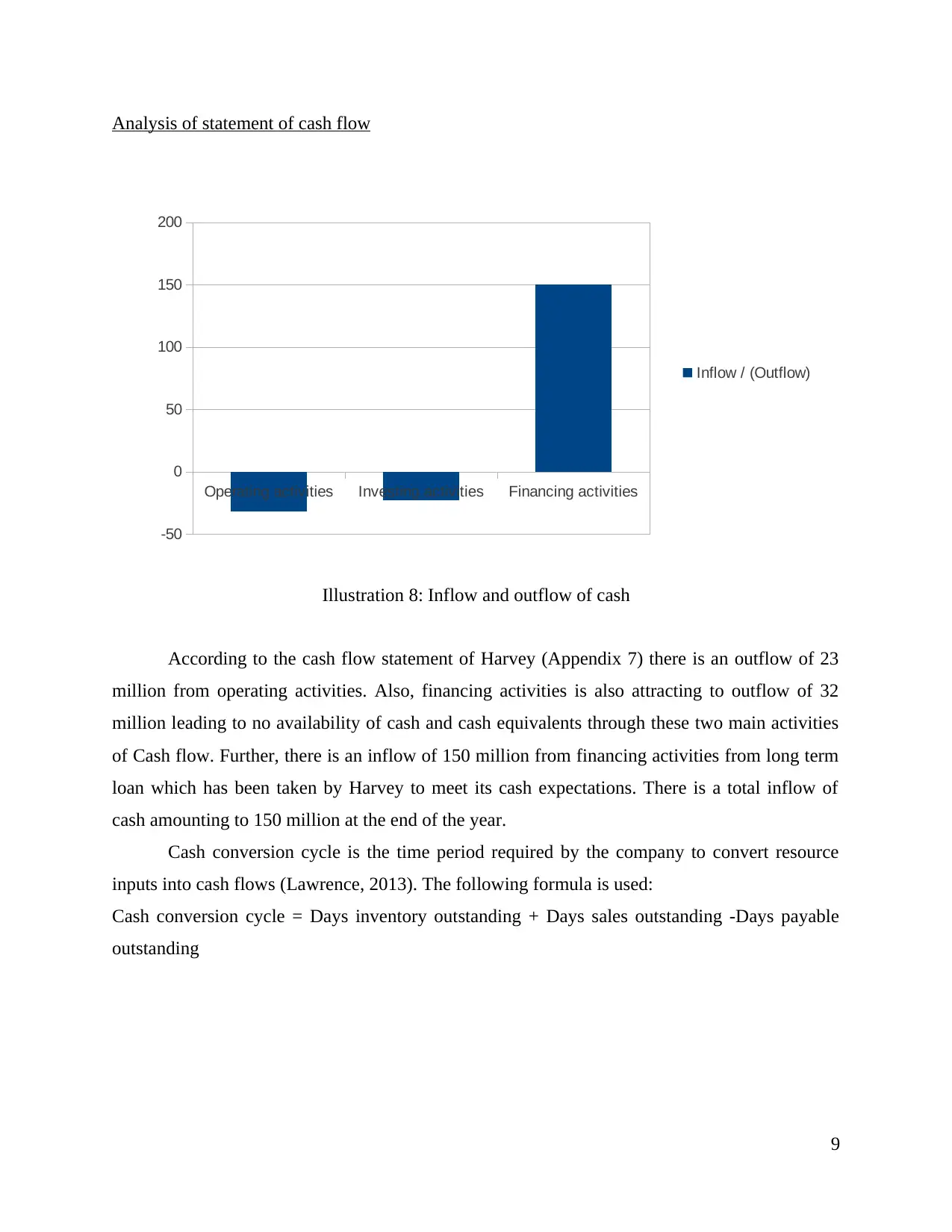
Analysis of statement of cash flow
According to the cash flow statement of Harvey (Appendix 7) there is an outflow of 23
million from operating activities. Also, financing activities is also attracting to outflow of 32
million leading to no availability of cash and cash equivalents through these two main activities
of Cash flow. Further, there is an inflow of 150 million from financing activities from long term
loan which has been taken by Harvey to meet its cash expectations. There is a total inflow of
cash amounting to 150 million at the end of the year.
Cash conversion cycle is the time period required by the company to convert resource
inputs into cash flows (Lawrence, 2013). The following formula is used:
Cash conversion cycle = Days inventory outstanding + Days sales outstanding -Days payable
outstanding
9
Operating activities Investing activities Financing activities
-50
0
50
100
150
200
Inflow / (Outflow)
Illustration 8: Inflow and outflow of cash
According to the cash flow statement of Harvey (Appendix 7) there is an outflow of 23
million from operating activities. Also, financing activities is also attracting to outflow of 32
million leading to no availability of cash and cash equivalents through these two main activities
of Cash flow. Further, there is an inflow of 150 million from financing activities from long term
loan which has been taken by Harvey to meet its cash expectations. There is a total inflow of
cash amounting to 150 million at the end of the year.
Cash conversion cycle is the time period required by the company to convert resource
inputs into cash flows (Lawrence, 2013). The following formula is used:
Cash conversion cycle = Days inventory outstanding + Days sales outstanding -Days payable
outstanding
9
Operating activities Investing activities Financing activities
-50
0
50
100
150
200
Inflow / (Outflow)
Illustration 8: Inflow and outflow of cash
⊘ This is a preview!⊘
Do you want full access?
Subscribe today to unlock all pages.

Trusted by 1+ million students worldwide
1 out of 27
Related Documents
Your All-in-One AI-Powered Toolkit for Academic Success.
+13062052269
info@desklib.com
Available 24*7 on WhatsApp / Email
![[object Object]](/_next/static/media/star-bottom.7253800d.svg)
Unlock your academic potential
Copyright © 2020–2025 A2Z Services. All Rights Reserved. Developed and managed by ZUCOL.





